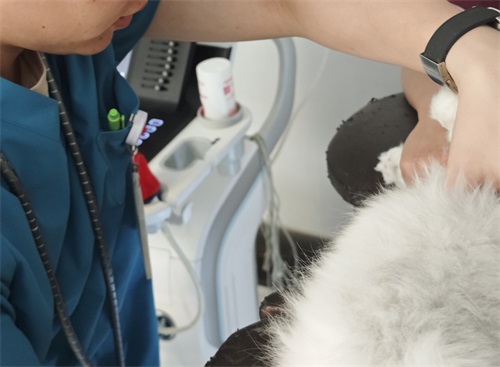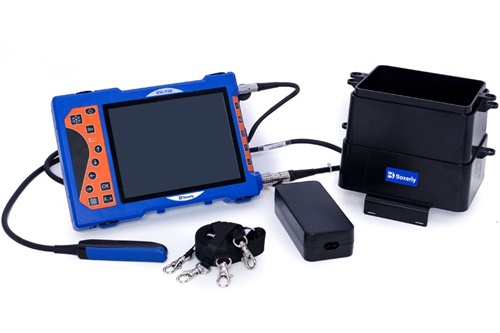Launching a new veterinary hospital is a thrilling endeavor—filled with ambition, responsibility, and the expectation to deliver high-quality care from day one. To meet these expectations and establish a reputation for excellence, having the right diagnostic tools is critical. They’re not just about detecting illness—they’re about practicing proactive medicine, providing clarity to clients, and building lasting trust with pet owners.

From my research and experience with global veterinary practices, I’ve identified five essential diagnostic tools that form the cornerstone of modern veterinary clinics. These technologies are widely embraced in practices across the United States, Europe, and parts of Asia, and each brings immense value to clinical workflows and patient outcomes. Let's explore them in detail, including real-world examples to illustrate their impact.
1. TonoVet Plus Tonometer: Measuring Intraocular Pressure with Precision
Ophthalmic health is often overlooked in pets, but early detection of ocular conditions like glaucoma can prevent irreversible vision loss. The TonoVet Plus Tonometer is a game-changer in veterinary ophthalmology, offering a non-invasive and anesthesia-free solution for measuring intraocular pressure (IOP).
Key Features:
Species-specific calibration (dogs, cats, rabbits, horses)
Red/green lights for easy alignment
Automated averaging of six measurements
Lightweight, ergonomic design for one-handed use
Case Example:
During a wellness exam, a 12-year-old indoor cat named Chloe presents with slight lethargy and unequal pupil size—subtle signs that could be dismissed. A quick tonometry scan reveals elevated IOP in one eye, prompting immediate referral and early glaucoma management. This simple test potentially saved Chloe’s eyesight and deeply impressed her owner with your attention to detail.
Tonometers like the TonoVet Plus are widely recommended in global veterinary best-practice guidelines and have become a mainstay in both primary and specialty eye care.
2. Digital Radiography (X-ray): Clear Imaging for Confident Decisions
Digital x-ray systems have revolutionized veterinary diagnostics, replacing older film-based systems with faster, clearer, and safer imaging. A quality digital radiography system provides instant results, enhances diagnostic accuracy, and integrates seamlessly into practice management software.
Benefits:
Instant image viewing and storage
Higher resolution for better interpretation
Less radiation exposure
Improved efficiency and patient throughput
Case Example:
A middle-aged cat is brought in with vague abdominal discomfort. The digital x-ray reveals a string foreign body lodged in the intestines. Immediate surgery is scheduled, and the pet recovers well—demonstrating how fast and accurate imaging can be life-saving.
In many Western clinics, digital X-ray is no longer optional—it’s a core part of the diagnostic suite, enabling faster triage and higher standards of care.
3. Veterinary ultrasound: Real-Time Internal Imaging Across Species
Ultrasound, particularly B-mode veterinary ultrasound, is indispensable for real-time internal visualization. Whether it’s assessing pregnancy, abdominal organs, or musculoskeletal injuries, ultrasound provides non-invasive, high-resolution insight without the need for radiation.
One popular portable unit, BXL-V50, has become favored among rural and mixed-animal practices for its clarity and adaptability.

Key Advantages:
Real-time feedback for accurate scanning
Non-invasive and safe for repeated use
Portable units available for fieldwork
Ideal for pregnancy checks, fluid detection, and organ evaluation
Case Example:
A goat on a small farm is suspected to be pregnant, but timing is uncertain. A field ultrasound with the BXL-V50 confirms twin pregnancies, and the farmer adjusts nutrition accordingly. Later, the same unit is used for monitoring post-partum uterine involution in another doe.
Ultrasound technology is gaining momentum not just in urban clinics but also in mobile and large-animal settings across Europe and Australia. Many veterinary associations recommend ultrasound as a first-line imaging tool for soft tissue assessment.
4. Dental X-Ray Systems: Seeing Beyond the Gum Line
Veterinary dentistry is one of the most overlooked but critical aspects of companion animal care. Dental radiographs allow clinicians to detect painful pathologies—such as resorptive lesions, periodontal disease, and fractured roots—that are invisible during a standard exam.
Why It Matters:
Diagnoses hidden dental problems early
Enhances surgical planning and tooth extraction
Improves client understanding and acceptance of treatment
Increases revenue through dental packages
Case Example:
Penny, a senior Labrador retriever, presents for a routine dental cleaning. Her teeth appear normal externally. However, dental X-rays uncover extensive root damage and early jaw bone loss. Thanks to early detection, the issues are treated before they lead to infection or systemic disease.
Globally, dental imaging is becoming standard in small animal care. In the U.S., the American Veterinary Dental College strongly advocates for full-mouth radiographs during all dental cleanings—advice increasingly echoed in the UK, Canada, and New Zealand.

5. Laser Therapy Devices: Enhancing Healing Without Medication
Laser therapy is a relatively recent but fast-growing addition to veterinary medicine. This non-invasive modality uses light energy to reduce inflammation, promote circulation, and accelerate healing—especially in post-op cases, arthritis, soft tissue injuries, and wounds.
Benefits:
Drug-free pain management
Faster post-surgical recovery
Excellent for chronic conditions like osteoarthritis
Easy to use and well-tolerated
Case Example:
A rabbit named Johnny has a non-healing wound despite antibiotics and dressings. After just a few short laser therapy sessions, the wound heals significantly, and Johnny resumes eating and moving normally.
In countries like Germany, Sweden, and Japan, laser therapy is standard in many animal hospitals, especially for geriatric patients and post-surgical rehab. It adds value by improving outcomes and reducing reliance on long-term medications.
Investing in Diagnostic Excellence
Diagnostic tools are more than just equipment—they’re your practice’s frontline defense against disease progression and client dissatisfaction. Starting strong with a well-equipped diagnostic suite shows pet owners that you’re serious about providing high-quality care.
Here's why global veterinary leaders prioritize diagnostics:
Client trust: Clear diagnoses help explain medical conditions and justify treatment costs.
Proactive medicine: Early detection means better outcomes and less invasive treatments.
Efficient workflow: Fast, accurate tools reduce appointment times and improve throughput.
Team empowerment: Vet techs and junior doctors can confidently contribute to patient assessment with clear data.
Conclusion
The five diagnostic tools discussed—TonoVet Plus Tonometer, digital x-ray, veterinary ultrasound (e.g., BXL-V50), dental x-ray systems, and laser therapy devices—are not just useful add-ons. They are foundational instruments that directly impact diagnostic accuracy, treatment effectiveness, and overall client satisfaction.
By investing in these technologies, your new veterinary practice can hit the ground running with a reputation for excellence. Clients will feel more confident entrusting their pets to you, and your team will be empowered to deliver modern, comprehensive care.
As practices around the world continue to elevate standards with better diagnostics, there’s no better time to ensure your clinic is equipped to lead the way.
References:
American Veterinary Medical Association. (2023). Veterinary Equipment Recommendations for New Clinics. https://www.avma.org
The Royal College of Veterinary Surgeons. (2022). Essential Diagnostic Equipment in Small Animal Practice. https://www.rcvs.org.uk
International Veterinary Academy of Pain Management. (2023). Laser Therapy in Companion Animal Practice. https://www.ivapm.org
Beef Cattle Institute. (2023). Use of Ultrasound for Growth Evaluation in Cattle. https://www.beefcattleinstitute.org/ultrasound-growth
American College of Veterinary Ophthalmologists. (2022). Tonometry in Small Animal Practice. https://www.acvo.org
American Veterinary Dental College. (2023). Veterinary Dental Radiography Guidelines. https://www.avdc.org
tags:
Text link:https://www.bxlultrasound.com/ns/848.html


